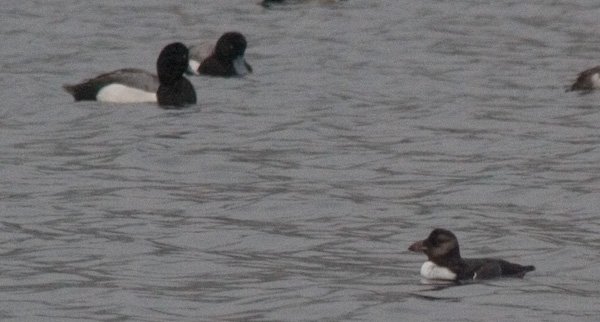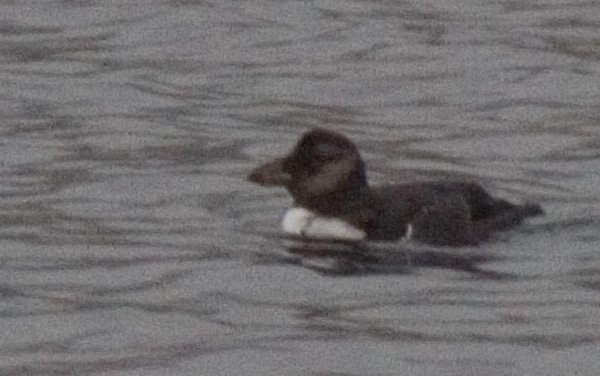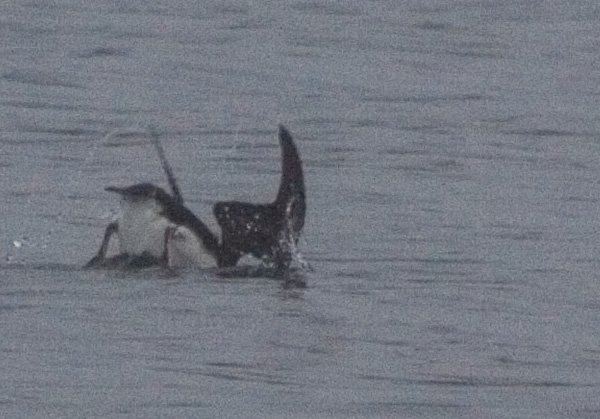
Last Sunday a Horned Puffin was reported from Middle Channel not too far from Rose Rock. This was a pretty good sighting, as puffins are not commonly seen this close to town any time of year. Even in the summer when puffins are fairly easy to find out in the sound, the vast majority of those birds are Tufted Puffins. There are a few Horned Puffins that do nest in the general area (near Sitka Point on South Kruzof, for example), just in smaller numbers than the Tufted Puffins that nest on St. Lazaria. I figured there was not too much chance that the bird would stick around in these relatively shallow waters, so I did not worry about trying to get out there to see it.
Yesterday my last class finished at 3pm and I had a message waiting from the person who reported seeing a puffin Sunday. There was a Horned Puffin spotted again in the channel from the Japonski Island side. I went home and grabbed a pair of binoculars and my bicycle (I try to always have my camera with me, too many times have I missed something without it). When I arrived over on the ramp, it only took a minute to spot a strange looking bird preening just off the groups of scaups and Long-tailed Ducks that frequent the channel in winter. It was hard to get a good look at it, but it did look promising. After a few moments, I decided it was almost certainly the Horned Puffin. It had the look of an alcid with a very white chest and belly. It was turned away from me, so I had a hard time getting a great look at the head and beak at first.
While I was paying attention to the preening bird, I noticed a second bird that reminded me of an alcid swimming along and diving repeatedly. It would only surface for a couple of seconds before diving again, but it moved from right to left in front of me. After I was fairly confident I had seen the Horned Puffin that was reported, I decided to investigate this other alcid a little more carefully. I figured it was probably a Marbled Murrelet or something, but it didn’t seem quite right for that. I walked up the beach to try getting ahead of it so I would be ready when it next surfaced. After a couple of tries I was successful and saw that it was a Horned Puffin.

I looked back to where I had first seen the Horned Puffin that was preening and it was now gone. I could not be sure that the bird that had surfaced near me was the same one I thought I was following and not the one I had been watching while it preened. I decided to sit down and watch for awhile. Over the hour or so I spent there, I saw puffins surfacing and diving frequently. Mostly they were some distance from me, but their shape and diving style were fairly distinct, so it was not too hard to distingiush them from the Long-tailed Ducks and scaups that were also diving in the area.

As I understand it, alcids use their wings for propulsion underwater rather than their feet. When they tip over and diving, their feet are fairly relaxed and their wings spread as they begin propelling themselves underwater. The Long-tailed Ducks also use wings for propulsion (unlike other sea ducks), but their shape, coloring and motion in entering the dive are different enough that it was usually pretty easy to tell they were not puffins. The scaups dive/swim using their feet, so they never spread their wings upon starting to dive.
The puffins were surfacing only for moments, and it was difficult to tell where they would come up next. For quite a while I had the sense that there was more than one puffin, but I never saw more than that at one time. Eventually I saw two puffins on the surface at the same time fairly close together. This confirmed there was more than one, but it still seemed like there had to be more of them. After the or two I saw would dive, the next one would pop up a short time later some distance away. The time seemed too short and the distance too great for the bird to swim underwater, but I couldn’t be positive. Finally I saw two close to me and almost immediately after they dove, what appeared to be two more on the other side of the channel. They were far enough away that I’m not absolutely positive they were puffins, but I’m pretty confident. Assuming this is correct, that would be a total of 4 Horned Puffins close to shore. Although the pictures I was able to get are hardly nice sharp full-frame shots, I was certainly happy to be able to document these unusual visitors to town.
Update: I received an e-mail from someone who thought this sighting is probably quite unusual in the state for this time of year. The few winter sightings of Horned Puffins he had heard about were all off-shore. This would make the sightings here even more unusual than I had thought. It remains to be seen whether anyone can speak of other near-shore winter time Horned Puffin sightings elsewhere.